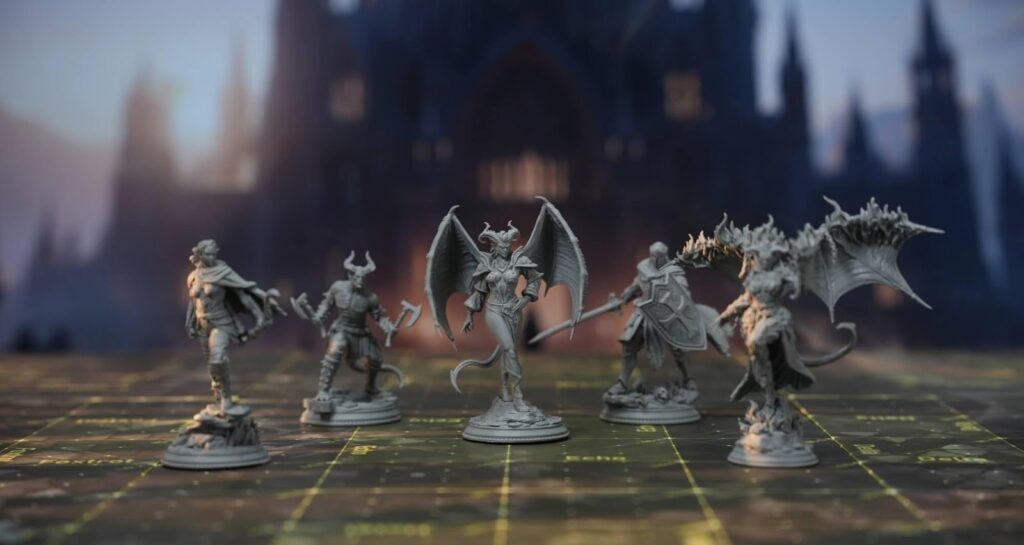3d resin printer has become a go-to method for producing highly detailed miniatures. However, not all 3d printer resin performs equally. The right material can preserve fine textures, resist chipping, and simplify post-processing, while the wrong choice can lead to brittle models or a frustrating cleanup process.
This guide will help you identify what matters when choosing resin for miniatures and introduce three options for different needs.

What Makes a Good Resin for Miniatures?
Miniatures require precision. The ability of resin to capture fine surface details, such as facial expressions, armor engravings, or fabric textures, is critical. A good miniature resin should offer:
- Detail Preservation: Miniatures often feature intricate textures like armor engravings, scales, and small accessories. Standard resin may struggle to capture these fine elements, leaving the final print looking flat or lacking definition.
- Durability: Tabletop miniatures are frequently handled, moved, and sometimes dropped. If the resin is too brittle, fragile parts may break easily, resulting in reprints and added material costs.
- Flexibility: For thin or extended features such as swords, staffs, or wings, a slight degree of flexibility is essential. The resin should bend slightly under pressure without compromising overall stability or losing detail.
Detail Preservation: Miniatures are often covered in fine textures, such as armor engravings, scales, or small accessories. A typical resin may not be able to capture these details clearly, leaving your miniature looking bland or incomplete.
Durability: Tabletop miniatures aren’t just for show—they get moved around, dropped, and handled regularly. If your resin is too brittle, parts can snap off easily, leading to reprints and extra costs.
Flexibility: Especially with delicate elements like swords, staffs, or wings, miniatures need a resin that offers some flexibility without compromising the structure.
If the resin is too brittle, thin parts like swords or antennas may snap easily. If too soft, the miniature may deform or lose crisp edges during post-curing. Balance is key.
What to Look for in the Best Resin for Printing Miniatures
When choosing resin for miniatures, it’s important to consider several key properties that affect both print quality and practicality. Shore hardness and tensile strength determine how flexible or durable the cured model will be; tougher resins are better at withstanding frequent handling or accidental drops.
Viscosity plays a role in detail reproduction; lower-viscosity resins tend to flow more easily, which helps capture fine features and reduces the chance of trapped air bubbles.
Curing speed also matters: while faster-curing resins can improve productivity, they often require precise settings to prevent over-curing or warping.
Color is another consideration; light grey or white resins are popular for miniature painting, as they make surface flaws more visible during prep.
Finally, don’t overlook odor and safety. Some resins release strong fumes and require good ventilation, so low-odor formulations are often preferred for indoor or long-term use.
The 3 Best 3D Resins for Miniatures
Based on key miniature-printing needs, the following resins from the UltraPrint series stand out:
1. UltraPrint-Production PAF10
UltraPrint-Modeling PAF10 is a durable, flexible PVC-like material with high breakage resistance. With a water absorption rate of just 1.6% and strong anti-aging properties, it effectively resists cracking over time.
It offers excellent fine structure printability and smooth surface with invisible layer lines, making it ideal for models, figurines, and miniatures.
Key features:
- High toughness
- 1.6% water sorption
- Matte surface and well-defined details
- Resistant to long-term aging
2. UltraPrint-Production PAP10
UltraPrint-Production PAP10 is designed for miniatures & finely detailed structures. 3D-printed models can have cleaner edges, higher sharpness, and more delicate details.
Key features:
- Exceptional Detail
- Stable Structure
- Stable Performance – High tensile and modulus strength
- Ash Grey Color – Convenient for painting & finishing
- Black Color – Featuring sharper edges and textures.
3. UltraPrint-Modeling PAS10 Resin
PAS10 is a medium-viscosity, moderately strong, and tough resin. The finished products have a fully matte finish and outstanding visual performance, making it ideal for rapid prototyping applications in fields such as figurines and consumer electronics.
Note: PAS10 Resin in White and Black is currently out of stock in our UK, Germany, Australia, and Canada warehouses. Restocking is expected in early July for the UK and Germany, and mid-June for Australia and Canada.
Key features:
- Printing tolerance <0.05 mm – suitable for small batch production
- Smallest unsupported angle 25°- excellent forming ability
- Matte surface – no visible layer lines to the naked eye
- Not easily deformed or broken – impact resistant
Tips for Printing Miniatures with Resin
To achieve the best results when printing miniatures with resin, it’s essential to follow a few practical steps. Start by using thin layer heights, ideally between 0.025 and 0.05 mm, to preserve fine details.
Delicate parts such as swords, horns, or thin limbs should be positioned at a slight angle to reduce stress during curing. Support placement is also critical. Add supports carefully under overhangs and narrow tips to avoid deformation or failed prints.
After printing, wash your models promptly to remove uncured resin and prevent residue buildup. For consistent results, post-cure the model evenly, which helps avoid patchy hardening or color inconsistencies.
Finally, plan ahead for post-processing. If you intend to paint your miniatures, priming is often necessary, and some resins adhere to primer better than others—testing in advance can save time and effort.
Explore: https://baddiehub.news/category/technology/
Conclusion
Choosing the best resin for miniatures isn’t just about buying the most expensive product — it’s about matching your specific needs. For durable, game-ready pieces, PAP10 offers a good balance. For general-purpose use, PAF10 delivers reliable prints with clean detail. And for display-level precision, PAS10 stands out.
As always, careful calibration and post-printing work are necessary to bring out the best in your models. Pay attention to how your resin behaves during curing, and don’t hesitate to test small prints before committing to full-scale projects.
Whether you’re a hobbyist or working on a professional miniature series, the right resin makes a noticeable difference. Choose wisely, and your models will speak for themselves.
Source: Baddie Hub






